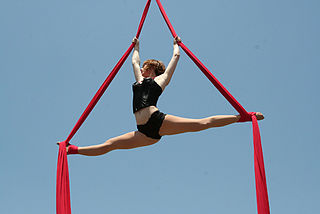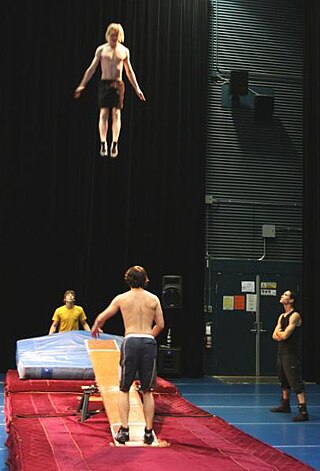
Acrobatics is the performance of human feats of balance, agility, and motor coordination. Acrobatic skills are used in performing arts, sporting events, and martial arts. Extensive use of acrobatic skills are most often performed in acro dance, circus, gymnastics, and freerunning and to a lesser extent in other athletic activities including ballet, slacklining and diving. Although acrobatics is most commonly associated with human body performance, the term is used to describe other types of performance, such as aerobatics.

A trapeze is a short horizontal bar hung by ropes, metal straps, or chains, from a ceiling support. It is an aerial apparatus commonly found in circus performances. Trapeze acts may be static, spinning, swinging or flying, and may be performed solo, double, triple or as a group act.
Saltimbanco was a touring show by Cirque du Soleil. Saltimbanco ran from 1992 to 2006 in its original form, performed under a large circus tent called the Grand Chapiteau; its last performance in that form was in Rio de Janeiro, Brazil, on December 10, 2006. A new adaptation of the show started touring North America on July 31, 2007, with its first stop in London, Ontario, Canada. The new version was staged in arenas with fewer performances in each city it visited. The new version closed at the end of 2012.

Alegría is a Cirque du Soleil touring production, created in 1994 by director Franco Dragone and director of creation Gilles Ste-Croix. It takes its name from the Spanish word for "joy".
Mystère is one of six resident Cirque du Soleil shows in Las Vegas, Nevada. Held in a custom theatre at the Treasure Island Hotel and Casino, the show was first performed on 25 December 1993, making it the company's longest running show. As with many Cirque du Soleil productions, Mystère features a mixture of circus skills, dance, elaborate sets, opera, worldbeat music, and street theatre-style comedy. Featuring a musical score composed by René Dupéré and Benoît Jutras, the show was created under the direction of Franco Dragone.

La Nouba was a Cirque du Soleil show that ran for 19 years in a custom-built, freestanding theater at Disney Springs' West Side at the Walt Disney World Resort in Lake Buena Vista, Florida. It was a contemporary circus performance featuring acrobats, gymnasts, and other skilled performers. The show's creation was directed by Franco Dragone, who also directed many of Cirque du Soleil's earlier shows. Its title derives from the French phrase faire la nouba, meaning "to party" or "to live it up".

The Russian bar is a circus act which combines the gymnastic skills of the balance beam, the rebound tempo skills of trampoline, and the swing handstand skills of the uneven bars and the parallel bars. The bar itself is a flexible vaulting pole around 4 to 4.5 metres long, typically made of fiberglass; three vaulting poles may also be fastened together to create a flexible beam. The act involves two bases balancing the bar on their shoulders, and one flyer standing on the bar, with the flyer bouncing and performing aerial tricks and landing on the bar.

The teeterboard or Korean plank is an acrobatic apparatus that resembles a playground seesaw. The strongest teeterboards are made of oak. The board is divided in the middle by a fulcrum made of welded steel. At each end of the board is a square padded area, where a performer stands on an incline before being catapulted into the air. The well-trained flyer performs various aerial somersaults, landing on padded mats, a human pyramid, a specialized landing chair, stilts, or even a Russian bar.

The cradle is a type of aerial circus act in which a performer hangs by his or her knees from a large rectangular frame and swings, tosses, and catches another performer. The aerialist being swung is referred to as a flyer, while the one doing the tossing and catching is referred to as a catcher or caster. The flyer usually starts and ends standing on the frame above the catcher. The flyer swings holding on to the catcher's hands, performs releases at the top of the swing, and is re-caught in mid-air.

Static trapeze, also known as fixed trapeze, is a type of circus apparatus. In contrast to the other forms of trapeze, static trapeze the bars and ropes mainly stay in place.

Nouvelle Expérience was Cirque du Soleil's fourth touring circus show, which premiered in 1990.
Alfredo Codona was a Mexican trapeze artist who was a member of the world-famous "Flying Codonas" and was the first aerialist to continually perform the triple somersault. Alfredo came from an itinerant performing family whose origins lie with the Codoni family in the Italian speaking area of Canton Ticino in southern Switzerland.
This is a general glossary of the terms used in the sport of gymnastics.

Ovo is a touring circus production by Cirque du Soleil that premiered in Montréal, Canada in 2009. Ovo's creator and director, Deborah Colker, took inspiration from the world of insects. The idea for Ovo was not to be about the acts, nor dancing, nor insects, but about movement. The movement of life permeates the entire show, with creatures flying, leaping, bounding, and crawling. Composer Berna Ceppas brought additional life to Ovo with a score inspired by the music of Brazil. Ovo means "egg" in Portuguese and represents the underlying thread of the show. Graphically, inside the logo of Ovo, is an insect. The two O's represent the eyes and the V forms the nose and antennas.
The Flying Caceres was created by Miguel Caceres in 1982 for the 112th Edition of Ringling Bros. and Barnum & Bailey Circus. Both Miguel and his wife, Luz Caceres, were flying trapeze artists from Colombia, South America. They came to the United States on a contract for Ringling Bros. and Barnum & Bailey Circus in the 1970s. Miguel worked with Ringling Bros. and Barnum & Bailey Circus for many years before forming The Flying Caceres in 1982.

Corde lisse is an aerial circus skill or act that involves acrobatics on a vertically hanging rope. The name is French for "smooth rope". In English-speaking parts of the world, it is also referred to as "aerial rope".

A Russian swing is a large, floor-mounted swing which is sometimes used in circus performances to make impressive high acrobatic jumps.
Kaely Michels-Gualtieri is an American trapeze artist known for her work as a leading artist with the Ringling Bros. and Barnum & Bailey Circus, often performing under the stage name "Electra". She is the winner of two Golden Flyer Awards as one of the world's leading swing trapeze artists. She won a Silver Ring, Russia's highest trapeze honor, in 2017. She is the youngest person ever nominated for membership in the Circus Hall of Fame.













